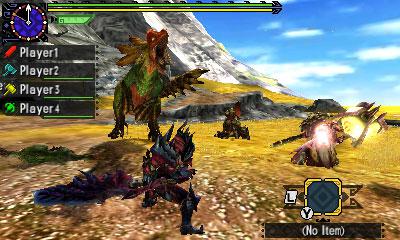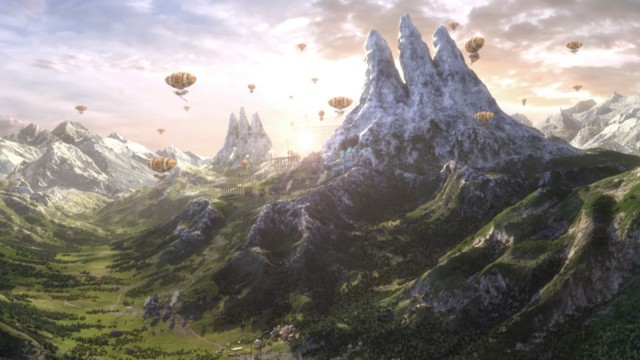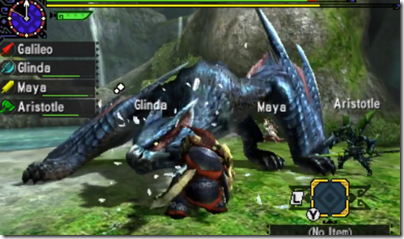Incredible production values; addition of Hunter Styles and Arts spices up combat; monster hunting and crafting as fun as ever; solid online play
Density and nuance will be off-putting to some players; Capcom keeps recycling too many assets for character creation
Monster Hunter as a franchise continues to make inroads into the West with each new release, topping the efforts of the previous games with tweaks to the series’ core gameplay that serve to please both new and longtime fans. As with Monster Hunter 4 Ultimate, developer Capcom has delivered a wildly fun sequel in the form of Monster Hunter Generations that largely outdoes what came before. The introduction of customizable Hunter Styles and Arts is the biggest change to the otherwise familiar formula on display here, but there are plenty of other new goodies to toy around with that make Generations easily the best Monster Hunter yet.
As ever, players begin Generations by creating a Hunter. I personally have come to find the character creation in Monster Hunter underwhelming from a visual standpoint, as this entry largely pulls the same old options that have existed as far back as Monster Hunter Tri. On the plus side, this redundancy makes it easier to carry over the look of a distinct Hunter design from previous entries, but otherwise I hope that Capcom branches out a bit in future installments to offer some improved character creation options. From a gameplay perspective, though, Generations does offer a greatly appreciated shot in the arm in the form of Hunter Styles. There are four Styles to choose from: Guild (which will feel most familiar to series veterans), Striker, Aerial, and Adept.

These Styles introduce new mechanics to gameplay that alter how players slay monsters. Aerial, for instance, grants a useful jumping dodge that can make avoiding danger easier. Sticking to a single Style might sound scary to longtime fans; after all, with a game that requires this much grinding and dedication, if a Style doesn’t suit someone’s playing preferences, it could result in a frustrating need to start over from scratch. Thankfully, Capcom has allowed Generations players to swap freely between the different Styles so that they can experiment with the new feature and find one (or more!) that works best for them. I greatly enjoyed messing around with the different Styles and feel that they helped generate more excitement during missions.
Arts, the other addition to gameplay that Generations brings along for the ride, are determined by the combination of weapon and Style that a player is currently rocking. Arts act basically like special moves, and whether pressing buttons or the touch screen to activate them, they’re super fun to use. I had a great deal of fun going through the different ones available, and they really helped make an impact during some of the more difficult battles later in the game. Generations might not offer too much of a different take on customizing the appearance of Hunters, but what it offers from a combat point of view more than makes up for that deficiency.

Capcom continues to make accessibility a priority for the Monster Hunter series with Generations, offering a lengthy and comprehensive introductory training mode right from the outset. Accessibility can sometimes come to mean hand-holding for some games (I’m looking at you, Nintendo), but Capcom understands that it’s a concept that works both ways; thankfully, for those who just want to jump into Generations without preamble, they can largely do exactly that. For players who need the helping hand, however, the training offered here is invaluable and makes learning the ins and outs of Monster Hunter a breeze. The game is as dense as ever, but there’s really no excuse to avoid Generations when it makes such pains to keep things approachable.
Palicoes make their return in this game with a number of missions to engage in. They come with their own armors and weapons to forge, and overall control quite differently than Hunters thanks to their lack of a stamina gauge and weaker overall attacks. It was a pleasure to go Felyne to tackle their missions; the Palico asides served to break up the core gameplay quite nicely. Coupled with the silky-smooth online play that the series has become known for, and there are plenty of options for players who want more than the basic, single-player monster-slaying that defines Monster Hunter. I’d recommend playing on New 3DS systems, if only to take advantage of the built-in C-Stick and somewhat better framerate, but even on older models of the handheld Generations is a solid experience.

I’d be remiss if I didn’t point out the incredible production values of Generations. This game has a killer soundtrack that permeates every battle and traipse through a town. Generations is running off of the same game engine as Monster Hunter 4 Ultimate, but that is by no means a bad thing; sometimes, the visuals are so stunning that I’d almost forget I was playing a handheld game. Generations is gorgeous, and the art direction has yielded some of the best-looking monsters yet seen from the series. It also offers a mix of enemies and locations from both the Sony and Nintendo eras of the franchise, making this a Monster Hunter fan’s dream mashup of old and new.
I don’t know that I can say with confidence Generations will be the Monster Hunter game to woo naysayers; it’s largely the same gameplay and mechanics that players have come to know for a decade now. Yet, given how stunningly Generations presents the series’ core combat and crafting, along with the introduction of Styles and Arts, makes it the best Monster Hunter title by a fair stretch– so much so, that I implore anyone who has yet to try the series to finally give it a look by picking up Generations. Nintendo’s home console might not get a lot of third-party love, but 3DS isn’t in quite the same boat; this is a triple-A production that any gamer should give a shot. Generations is a real gem at this late point in 3DS’s life cycle.
Nintendojo was provided a copy of this game for review by a third party, though that does not affect our recommendation. For every review, Nintendojo uses a standard criteria.




 ShareThis
ShareThis





